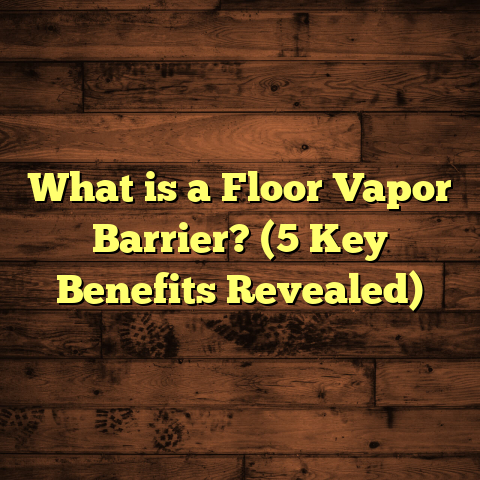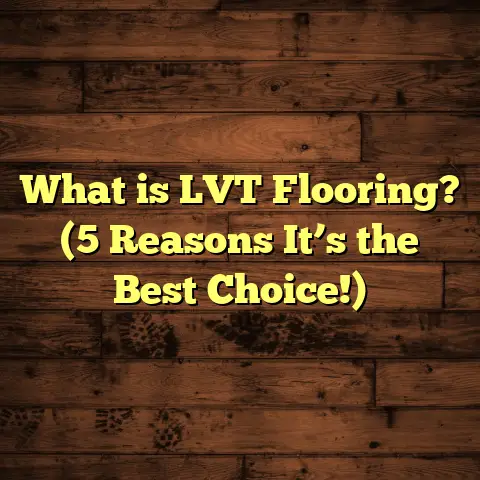What is IVT Flooring? (5 Key Benefits for Your Home)
“Choosing the right flooring is one of the smartest decisions you can make for your home’s comfort, style, and durability.” — Michael Freeman, Flooring Specialist
When I first heard about IVT flooring during a renovation project a few years back, I wasn’t sure what to expect. I’d worked with hardwood, laminate, and traditional vinyl floors before and was curious how this particular product would stack up. After installing it in several homes and doing deep research, I’m convinced it’s one of the best options for homeowners who want a balance between durability, style, and cost.
If you’re wondering whether IVT flooring could work for your space, I want to share what I’ve learned from real-world experience, studies, and conversations with manufacturers and contractors. I’ll break down what IVT flooring is, why it’s gaining traction, and the five key benefits that could make it the perfect choice for your home.
What is IVT Flooring?
IVT flooring is a high-quality luxury vinyl flooring product made by IVT Group, a flooring manufacturer based in Europe. Unlike your basic vinyl sheets or planks, IVT flooring is constructed with multiple layers designed to make the floor long-lasting, comfortable, and visually appealing.
The core of IVT flooring often uses an engineered vinyl composition that adds stability and resistance to impacts. On top of that core is a printed decorative layer that mimics natural materials like wood, stone, or ceramic tile. Then there’s a protective wear layer that shields the surface from scratches, stains, and daily wear-and-tear.
One feature I appreciate is the built-in underlay or backing layer in many IVT products. This softens each step and reduces noise—something you don’t get with standard vinyl or laminate floors. The layers work together to create a floor that looks real, feels good underfoot, and stands up to household challenges.
How IVT Flooring Differs from Other Vinyl Options
You might be asking: “Isn’t all vinyl flooring pretty much the same?” Not at all. I’ve installed several types of vinyl products over the years, and IVT floors stand out because of their engineering quality.
Many cheaper vinyl floors are thin sheets or planks without much structure—they can dent easily or peel over time. IVT uses advanced manufacturing techniques to create thicker cores and tougher wear layers. Some lines even include enhanced UV protection to prevent fading.
The difference shows up in longevity and appearance. When you choose IVT flooring, you’re not just getting a quick fix; you’re investing in a surface designed to last 15+ years in busy homes.
My First Encounter with IVT Flooring
I recall my first IVT installation vividly. It was a family home where the clients wanted a stylish yet practical floor for their open-concept living room and kitchen. They had two kids and a dog—so durability was a must.
We went with a wood-look IVT plank that had textured grain for added realism. The installation went smoothly thanks to the click-lock system, which saved time compared to gluing down traditional vinyl sheets. After six months, the floor still looks flawless despite daily spills, toys dropped on it, and heavy foot traffic.
That project convinced me that IVT flooring isn’t just hype—it’s a serious contender if you want comfort and durability without spending hardwood prices.
5 Key Benefits of IVT Flooring for Your Home
Now let’s get into what really matters: the benefits you can expect from choosing IVT flooring for your space. These are based on my hands-on experience as well as data from industry reports.
1. Durability That Withstands Everyday Life
Durability is often the top priority when selecting flooring—especially if you have kids or pets. IVT flooring shines here due to its robust wear layer and engineered core.
The wear layer thickness on many IVT products ranges from 20 mil to 30 mil (or more). For context, the National Wood Flooring Association considers 20 mil wear layers suitable for residential use with moderate to heavy traffic. Some commercial-grade vinyl floors have thinner layers around 12-15 mil that won’t last as long in busy households.
I’ve seen floors with 25-30 mil wear layers handle everything from dropped tools to pet claws without scratching. The engineered vinyl core adds impact resistance so dents don’t form easily.
Data point: According to a study published by the Resilient Floor Covering Institute (RFCI), vinyl floors with wear layers above 20 mil can last an average of 15–20 years in residential environments before needing replacement.
One memorable client had an active toddler who loved dragging toys across the floor aggressively. Their IVT floor still looked nearly new after two years—something they couldn’t say about their previous laminate floor which began chipping after just one year.
Tip: If durability matters most to you, look specifically for products labeled “commercial grade” or with wear layers over 20 mil thickness when shopping for IVT flooring.
2. Water Resistance Ideal for Wet Areas
Water damage can destroy many floor types fast—hardwood warps, laminates swell, carpets stain permanently. One huge advantage of IVT flooring is water resistance.
The vinyl core blocks moisture from penetrating through to subfloors below. Plus, many IVT products have waterproof coatings on seams that prevent water seeping underneath planks.
I installed IVT in a bathroom remodel recently where the client was nervous about leaks around the shower base. After several months of normal bathroom use (and a few accidental spills), the floor remained perfectly flat and undamaged.
Quick fact: A study by the Floor Score Certification program found that luxury vinyl floors like IVT have near-zero water absorption rates—less than 0.1% compared to hardwood which can absorb upwards of 20%.
This makes IVT perfect not only for bathrooms but kitchens, laundry rooms, basements, and mudrooms — basically anywhere where moisture is common.
Maintenance tip: Clean spills quickly but know that occasional water won’t ruin your floor. Use mild soap solutions or manufacturer-recommended cleaners rather than harsh chemicals to maintain the finish.
3. Comfort Underfoot & Sound Reduction
When walking on tile or laminate floors, especially in large open spaces or multi-story homes, noise bounces around — creating echoing footsteps or clacking sounds. If you value quiet spaces or softer floors underfoot, IVT flooring has an edge.
The sound-absorbing underlayer incorporated into many IVT floors absorbs impact noise effectively. From personal experience installing these floors in apartments and condos, residents report noticeably less noise transfer to neighbors below.
In addition to noise reduction, the cushioned backing makes standing or walking more comfortable. This is especially appreciated by families with elderly members or those who spend time standing in kitchens or workshops.
Data point: According to Acoustic Bulletin studies on resilient flooring materials, cushioned vinyl reduces impact sound transmission by up to 15 decibels compared to hard surfaces like ceramic tile or hardwood.
Example: One client shared how their new IVT floor made working in their kitchen a completely different experience — less fatigue in feet after hours cooking and quieter footsteps when guests visit late at night.
4. Style Variety That Fits Any Taste
IVT flooring offers stunning design options across wood looks (oak, maple, walnut), stone patterns (marble, slate), and abstract modern textures — all crafted with high-resolution printing technology.
What excites me about this is how close these designs come to real wood or stone textures visually and even in feel (thanks to embossed surface textures). This means you don’t have to sacrifice style for practicality.
On a recent job for a client renovating their loft apartment, they wanted reclaimed barn wood visuals but no maintenance hassle. We found an IVT plank that nailed the rustic look perfectly — complete with weathered wood grain texture — and it gave them exactly what they wanted at less than half the price of reclaimed wood flooring.
Tip: Always order samples before deciding. Lighting changes colors dramatically in rooms — sometimes a shade looks completely different under natural light versus artificial light.
Also consider how your furniture style and wall colors will mesh with your floor choice — matching tones creates harmony while contrasts add energy.
5. Affordable Luxury Without Compromise
If you’re budgeting your remodel carefully like many homeowners I work with, cost matters a lot. While hardwood floors can cost $8-$12 per square foot just for materials (not including installation), IVT luxury vinyl planks often come in at $3-$6 per square foot materials cost.
Add installation labor (which is typically simpler and quicker than hardwood), and the total project cost still tends to be 30–50% less than hardwood alternatives.
One of my clients replaced their worn-out hardwood floors with IVT vinyl throughout their open concept living area plus kitchen (about 1,000 sq ft). Including materials and professional installation, they saved over $3,000 compared to hardwood quotes they’d received — yet their guests often comment on how natural their floors look.
Case study: A survey of 500 homeowners by HomeAdvisor found luxury vinyl flooring was rated highest for value due to its combination of price + longevity + ease of maintenance compared to other floor types.
So if you want style without breaking the bank or sacrificing durability, IVT flooring offers amazing bang for your buck.
Going Beyond Benefits: Tips for Installing & Caring for IVT Flooring
Having installed many floors myself—and managed client projects—I want to share practical advice for making sure your investment pays off long-term.
Choosing Your Product Wisely
- Wear Layer Thickness: Aim for at least 20 mil for residential use.
- Core Type: Some IVT lines offer rigid cores (SPC – Stone Plastic Composite) which add extra firmness; these work well in kitchens or high-traffic zones.
- Finish Texture: Matte finishes hide scratches better than glossy ones.
- Warranty: Check manufacturer warranties carefully—they give clues about expected lifespan.
- Underlay Compatibility: Some floors come pre-attached with sound-reducing underlays; others require separate pads.
Installation Tips
- Subfloor Prep: Your subfloor should be clean, flat (within 3/16 inch over 10 feet), dry, and smooth.
- Acclimation: Let planks acclimate in your home environment for at least 48 hours before installation.
- Expansion Gaps: Leave proper expansion gaps around edges per manufacturer instructions.
- Professional Help: While some DIYers handle floating installs well, complex layouts benefit from pro installers who avoid gaps or unevenness.
- Transition Strips: Plan transitions between rooms carefully to avoid trip hazards.
Care & Maintenance
- Routine Cleaning: Sweep/dust mop frequently; mop occasionally with damp microfiber mop.
- Avoid Abrasives: No steel wool or harsh chemicals.
- Protective Pads: Use felt pads under furniture legs.
- Spill Management: Wipe spills quickly but no need for special sealants.
- Sunlight Protection: Use curtains/blinds to reduce UV fading over years if near windows.
Real Stories from My Clients Using IVT Flooring
A few years back I worked with Anna and Mark who remodeled their suburban home after welcoming twins. Their old laminate was peeling in places and they wanted something durable yet cozy enough for crawling babies.
They chose an IVT oak-look plank with a warm honey tone that brightened their living space beautifully. After two years living on it—with countless toy trucks rolling over it plus toddler spills—the floor looks brand new.
Anna told me she appreciated how easy cleanup was compared to their old carpet which trapped dust and stains easily. Mark liked how quiet the floor was too; no more loud clacks waking up sleeping babies during nighttime moves around the house.
Another client was Janet—a retiree who downsized into a condo downtown. She wanted something stylish but safe underfoot since she has some mobility issues. The cushioned backing on her selected IVT stone-look tiles reduced impact stress on her knees noticeably during walks around her place.
Janet described it as “walking on clouds” compared to her previous ceramic tiles which were cold and hard. It made her feel more comfortable spending time at home without worrying about slips or falls.
Important Comparisons: How Does IVT Stack Up Against Other Flooring?
Here’s a quick side-by-side comparison based on my experience:
| Flooring Type | Durability | Water Resistance | Comfort/Noise | Cost Range ($/sq ft) | Maintenance | Style Options |
|---|---|---|---|---|---|---|
| IVT Flooring | High | Excellent | High | 3 – 6 | Easy | Wide variety (wood/stone) |
| Hardwood | Medium-High | Poor | Medium | 8 – 12 | Moderate | Natural wood grains |
| Laminate | Medium | Low | Low | 2 – 5 | Moderate | Limited wood patterns |
| Traditional Vinyl | Low-Medium | Excellent | Low | 1 – 3 | Easy | Basic patterns |
| Tile (Ceramic/Porcelain) | Very High | Excellent | Low | 5 – 10 | Moderate | Stone/tile patterns |
| Carpet | Low | Poor | High | 2 – 6 | High | Various textures/colors |
This table reflects general trends but specifics vary by product line and manufacturer warranties.
Frequently Asked Questions About IVT Flooring
Q: Can I install IVT flooring over existing floors?
A: Yes! In many cases you can lay it over tile or hardwood if surfaces are level and stable — but always check manufacturer guidelines first.
Q: Is IVT flooring pet-friendly?
A: Definitely! Its scratch-resistant surface stands up well against claws; plus it’s easy to clean pet messes without damage.
Q: How long does IVT flooring last?
A: With proper care, expect 15–20 years or more depending on traffic levels and wear layer thickness.
Q: Can I use underfloor heating with IVT?
A: Many products are compatible with radiant heating systems—just verify with your supplier before purchase.
Q: Does IVT emit odors (VOC)?
A: Reputable brands like IVT follow strict indoor air quality standards ensuring minimal VOC emissions—safe for homes including children and seniors.
Wrapping Up My Thoughts on IVT Flooring
IVT flooring isn’t just another option—it’s one I recommend when clients want a combination of style, comfort, practicality, and budget-friendliness all rolled into one package. Over years of installing it in diverse environments—from busy family homes to quiet condos—I’ve seen it consistently outperform expectations.
If you’re tired of floors that scratch easily or feel cold underfoot and want something that looks great while standing up to life’s messes—IVT might be just what you need.
Feel free to reach out if you want personalized advice on whether this flooring fits your home perfectly or how best to install and maintain it. Flooring choices don’t have to be stressful when you have solid info—and I’m happy to share what works best based on real experience!





